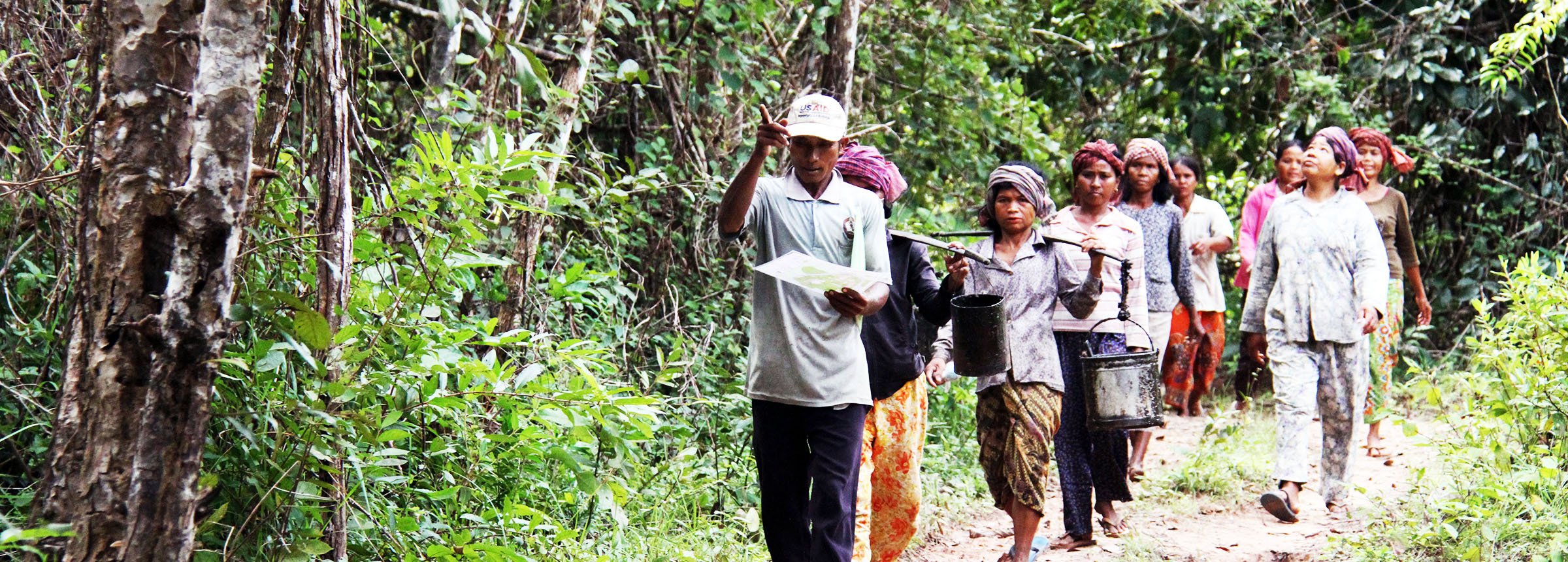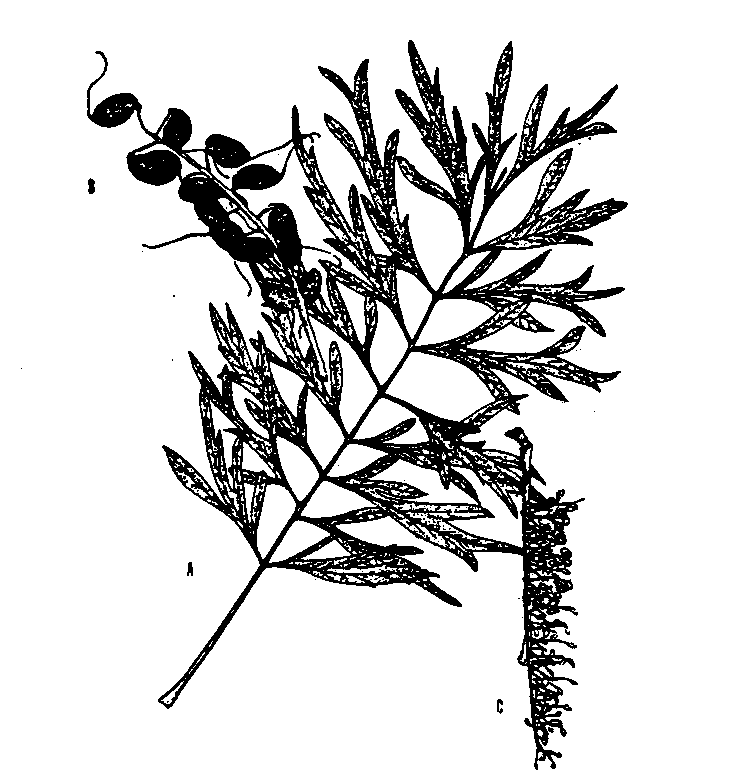
Grevillea robusta – a versatile and popular tree for farm forestry
FACT 98-05, September 1998
A quick guide to multipurpose trees from around the world
Grevillea robusta A. Cunn. ex R.Br., commonly known as Silky Oak or Silver Oak, has gained widespread popularity in warm temperate, subtropical and tropical highland regions of many countries, originally as a shade tree for tea and coffee and more recently as an agroforestry tree for small farms. It provides economically valuable products including timber, poles, firewood and leaf mulch; it is easy to propagate and establish and is relatively free of pests and diseases; its proteoid roots help it grow in low-fertility soils; it does not compete strongly with adjacent crops; and it tolerates heavy pruning of its roots and branches. With its fern-like pinnate leaves and prominent attractive orange flowering display, it is also popular as an ornamental.
 Botany
Botany
Grevillea robusta is the largest species in the genus Grevillea, in the plant family Proteaceae. It has no recognized subspecies or varieties, and no hybrids with other species have been recorded (McGillivray and Makinson, 1993). It is an erect single-stemmed tree typically reaching an adult size of 20–30 m in height and 80 cm in diameter in its natural range. The crown is conical and symmetrical with major branches spaced at intervals of about 1 m and projecting upwards at an angle of 45º. Bark on the trunk is dark gray and furrowed into a lace-like pattern. The fern-like foliage of this species is very distinctive. Leaves are 10–34 cm long and 9–15 cm wide, variably pinnate to bipinnate, with a smooth green upper surface and hairy silvery undersurface. Petioles are 1.5–6.5 cm long.
The bright orange flowers, about 2 cm in length, are borne in numerous pairs along the flower spikes, on pedicels 1.5 cm long. Fruits are two-seeded follicles 2 cm in length, with a slender persistent style. Seeds are winged, 13–19 mm long x 8-10 mm wide and 0.8–0.9 mm thick, with a papery wing around the brown, ovate central seed body.
Distribution
The natural habitat of G. robusta is in northern New South Wales and southern Queensland, Australia, where it occurs from the east coast to as far west as the Bunya Mountains, Queensland, up to an altitude of 1120 m (Harwood, 1992a).
Grevillea robusta has been introduced to warm temperate, subtropical and tropical highland regions around the world commencing in the mid to late 19th century and is widely planted in India, Sri Lanka, Central and South America and many countries in Africa (Harwood, 1989).
Environmental amplitude
The natural distribution is in the warm humid to warm sub-humid climatic zones. However, the species has performed well when introduced to a much wider range of climates. In its native range mean annual precipitation is 700-2000 mm and mean annual temperature is 15-20°C.
Towards the hotter extremes of the tolerated temperature range, the dry season should be no longer than 4 months for good growth. Grevillea robusta performs poorly in lowland tropical environments where mean annual temperature exceeds 23°C, and very wet locations where annual rainfall exceeds 2000 mm.
Grevillea robusta has some resistance to frost. During the winter months in temperate latitudes, it can survive temperatures down to minus 8°C with little or no damage, but milder frosts of only minus 2°C or so will cause damage during the growing season. Low-intensity ground fires will kill seedlings and young trees. It cannot withstand severe gales or persistent strong winds without damage to the branches.
Grevillea robusta prefers rather fertile soils such as those derived from river alluvia or basalts but will grow on shallower less fertile soils derived from sedimentary material. The pH range for good growth is around 4.5 to 7.5. Best growth is obtained on sandy loam, loam and clay loam textures. Heavy clay soils and prolonged waterlogging are not tolerated.
Uses
Wood. The air-dry density of heartwood is 550–650 kg m-3, that of sapwood and branches is lower. The heartwood is pale pink on cutting, darkening to red-brown after drying, while the sapwood is cream colored. The sawn timber is of medium strength and is used for furniture, packing cases, flooring, paneling, plywood and the manufacture of small wooden items such as pencils (Bolza and Keating, 1972; Skolmen, 1974). The wood produces short-fiber pulp of acceptable quality (Ghosh, 1972) but has not been used for pulp production on a commercial scale. The branches and twigs are used for firewood and charcoal. Poles are used for house construction in rural areas, scaffolding and rafters (Spiers and Stewart, 1992).
Agroforestry. Grevillea robusta is one of the most important trees for agroforestry in the tropical highlands of Eastern and Central Africa. It is commonly planted as a boundary tree around the perimeter of small farms, in a single row at 2–2.5 m spacing. It is also planted in rows between small fields, and as scattered individuals over crops such as coffee and maize (Spiers and Stewart, 1992). Akyeampong et al. (1995) found that G. robusta produced the highest wood volume (18.1 m3ha-1 at 3.5 years) of 9 tree species tested in agroforestry trials in Burundi when planted at 312 stems ha-1, intercropped with banana and beans. Yield of bananas was not affected to age 3.5 years, while bean yields were reduced by 29% in the 7th harvest at age 3.5 years.
In addition to their use as a soil mulch, the leaves of G. robusta are used by some farmers in the Embu district of Kenya as a fodder supplement for cattle in the dry season when other fodder sources are scarce (Spiers and Stewart, 1992). They are also used as bedding in livestock stalls.
Tea and coffee shade. From the late nineteenth century onwards, G. robusta has been planted extensively as high shade for tea and coffee plantations, and this use continues in many countries. The trees are often pollarded to produce a spreading crown, and have a typical working life of 40–50 years before they become senescent and must be replaced (Rao 1961). Shade trees of G. robusta provided effective protection against frost that caused extensive damage to open-grown coffee plants in southern Brazil at planting densities of 71 and 119 G. robusta trees per hectare, but not at 26, 34 and 48 trees per hectare (Baggio et al., 1997). In this study, economic productivity of coffee and grevillea wood at 34, 48 and 71 trees per hectare was greater than that of coffee in unshaded plantations. Only at 119 trees per hectare was there a significant (15%) reduction of total coffee production to age 10 years, relative to unshaded stands. Its use as tea shade has been largely discontinued in Kenya and Rwanda because of the risk of Armillaria and other root pathogens spreading from dead G. robusta roots to those of the tea plants (Tea Research Institute of East Africa, 1969).
Silviculture
Silvicultural characteristics. Grevillea robusta grows well in row plantings and as scattered trees over food and cash crops in warm temperate and subtropical climates. Recent studies on root architecture and water uptake indicate that G. robusta is relatively deep-rooted and thus may compete less with crop roots than do other trees (Howard et al., 1996). It tolerates repeated heavy pruning and pollarding, enabling farmers to regulate the degree of competition with adjacent crops.
Propagation. Propagation is usually from seed. There are about 40,000 viable seeds/kg. Seed will retain viability for at least five years if dried to below 8% moisture content and stored in a dry, cool (20°C or lower) environment (Jones, 1967; B.V. Gunn, CSIRO Forestry and Forest Products, pers. comm. 1998). No pretreatment is required for germination. Seedlings are pricked out when their second leaf-pair starts to develop, into tubes or plastic bags filled with a fertile loamy potting mix. Seedlings are grown for around 4-6 months in the nursery until planting out at a height of 20–40 cm during the rainy season. Cuttings can be easily struck using shoots of seedlings or saplings (Swain, 1928), which can also be air-layered.
Establishment. As the species is usually planted in rows or small woodlots, or as scattered individual trees, mechanical site preparation is seldom used. Some control of competing vegetation is required for the first 1–2 years after planting. This is normally achieved by several rounds of manual weeding. Fertilizer is seldom applied: 50 g per tree of an NPK fertilizer (12:12:12) applied shortly after planting would be appropriate for infertile soils.
Management. When planted in woodlots (2.5 m x 2.5 m) and line plantings (2–2.5 m between trees), thinning of inferior trees is often carried out at age of around 4-5 years to yield poles and firewood for local use or sale. Farmers in the African highlands commonly harvest branches by high pruning and pollarding every 3–4 years from age 4–6 years onwards (Poulsen, 1983; Spiers and Stewart, 1992). Some African farmers prune the surface roots of G. robusta by digging with a hoe at a distance of around 30 cm around the trunks of trees growing in and around fields, to reduce competition with adjacent crops.
Growth and yield. When grown at close spacings in plantations and woodlots, the growth rate of the species is relatively modest. For example, the estimated mean annual wood yield in tropical highlands is only some 10–12 m3ha-1 over 10–15-year rotations at recommended stocking of 800–1200 trees/ha (Pandey, 1987). Grevillea robusta is therefore not a high priority plantation timber species.
When it is planted singly or in lines, annual growth rates of 2 m (height) and 2 cm (diameter) over the first 5 years are commonly achieved in a number of countries where climate and soils are suitable.
Grevillea robusta coppices well after being cut back to ground level at ages of up to two years, but coppicing ability declines sharply thereafter, so management on a coppicing rotation is not feasible.
Symbiosis
The species does not form symbiotic associations with soil bacteria or mycorrhizal fungi, although it develops proteoid roots (sections of the secondary roots which develop as dense cylindrical clusters of rootlets, about 1 cm in diameter). These develop under conditions of low phosphorus availability are believed to enhance nutrient uptake. (Skene et al., 1996).
Limitations
In the humid tropical lowlands and other regions with high humidity, G. robusta is vulnerable to attack by fungal diseases such as Botryosphaeria dothidea (Guatemala; Schieber and Zentmeyer, 1978) and Corticium salmonicolor (Karnataka State, India; Nayar, 1987). In lowland environments in the Caribbean G. robusta is severely attacked by the scale insect Asterolecanium pustulans (Martorell, 1940) effectively precluding its use there. Attack by termites can be a problem when the species is planted on dry sites in Africa.
Grevillea robusta is an effective colonizing species and, in some cases, threatens to be a noxious weed (e.g. in Hawaii, Nelson and Schubert, 1976).
Provenances and genetic improvement
Provenance-progeny trials testing seed collections from across the natural range have recently been established in several countries including Australia, Kenya and Rwanda. These trials provide a good genetic base for breeding programs.
Selected References
Baggio AJ, Caramori, PH, Androcioli Filho A, Montoya, L, 1997. Productivity of southern Brazilian coffee plantations shaded by different stockings of Grevillea robusta. Agroforestry Systems, 37: 111-120.
Harwood CE, 1989. Grevillea robusta: an annotated bibliography. Compiled by C.E. Harwood. Nairobi: International Council for Research in Agroforestry (ICRAF).
Harwood CE, ed. 1992b. Grevillea robusta in Agroforestry and Forestry: Proceedings of an International Workshop. Nairobi: ICRAF.
Kalinganire A, 1996. Performance of Grevillea robusta in plantations and on farms under varying environmental conditions in Rwanda. Forest Ecology and Management, 80: 279–285.
A full set of references is available from FACT Net
Writted by C.E. Harwood, CSIRO Forestry and Forest Products, PO Box E4008, Kingston 2604, Australia, Fax: 61 26 2818266
Email: chris.harwood@ffp.csiro.au
A publication of the Forest, Farm, and Community Tree Network
